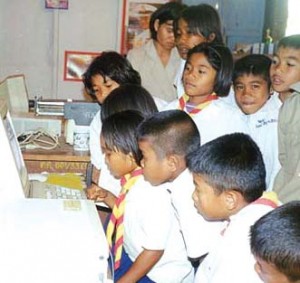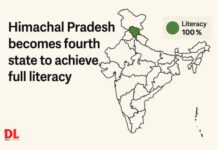 American India Foundation, through its
American India Foundation, through its
flagship “Digital Equaliser (DE)” programme has been working in underprivileged schools
to integrate technology as a pedagogical tool into the classrooms. The philosophy of the DE programme is that teachers are the pivots to
the school system and by creating an enabling environment the teachers would be empowered to make a choice on the use of technology as an additional tool in the teaching-learning process
Changing the traditional teaching-learning process is easier said than done, as
school systems which have been using the chalk-talk method find it very difficult to adopt newer systems. E-mail facilities are beginning to be used more in many schools as a management and administrative resource and also in limited cases as a teaching and learning resource. Internet access is becoming more common, but the use of the Internet for teaching and learning purposes is
very limited, due to high connectivity and telecommunication costs, lack of local content and examples, and inadequate technical and pedagogical support at local levels. Hence introducing an ICT program in a school means a lot more than just providing relevant content or technology training. Given the magnitude of the task, public-private-partnership is called for to ensure that children receive highquality learning and teaching. American India Foundation Digital Eqaliser (AIF-DE) programme leverages on these partnerships so that the program is implemented in a holistic and meaningful way and help the schools to build capacity within the school system to handle teaching learning through ICT.
Digital Equaliser programme
Digital Equalizer (DE) programme is a Computer Aided Learning initiative,which has been designed to bridge the digital divide with a vision- “An India where ALL children have access to resources and information that prepares them for participation in the digital age.” At the macro-level the DE programme has two elements with different phases. One is a pilot initiative where innovations on technology leading to reduced cost and improved quality in terms of programme design will be experimented on a continuous basis. The second is large-scale programme implementation through partnerships with governments where learning from the pilots would be adopted, adapted and appropriated for replication and scale.
Why AIF is involved in implementing the DE Program A. Bridging the Digital Divide
AIF believes that there is a need to prioritise access to ICT resources to the more underserved population, which is being left behind on a digital divide. Through its DE Programme AIF is providing opportunities to underserved children to enhance their learning through the use of digital technology and thereby bridging the divide and creating a level playing field. B. Quality learning AIF sees a direct convergence of technology and education where the
DE programme addresses the quality issue in the following ways.
1. Schools revising the present to create more effective learning environments and improving lifelong learning skills and habits in their students
2. In the process the teacher’s own learning abilities getting improved The DE methodology involves
• Enhancing basic literacy and critical thinking skills
• Enriching and improving the quality of education by enabling teachers to use technology in the teaching-learning process
• Inspire curiosity, confidence, and teamwork by actively engaging children in interactive, collaborative learning using technology and the Internet
DE programme implementation
• School selection is done based on availability of basic infrastructure, target group (Classes 6 to 10), teacher motivation to adopt the new system and management consent to support this activity.
• A Teacher trainer titled as “DE Co-ordinator” who is an AIF resource handles professional development and training for all subject teachers on ICT skills.
The trainer is allotted 5 to 10 schools in a cluster. If the teachers are not computer literate they are put through a computer literacy course before this phase.
• A Student Trainer titled as “DE Facilitator” placed in each school, handles student training on basic computer skills.
• ICT skills for teachers include creating multimedia lessons, using project based learning methods, use of Internet and leading tele-collaborative projects.
• Regular meetings are organised by the co-ordinators so that the schools get together and evaluate projects on an ongoing basis using feedback into the
system.
• From year 2, each school is encouraged to develop a school technology plan,
which will be tracked by the DE co-ordinator.
• Commencing from the third year the schools are expected to implement the
technology plan with minimal supervision from AIF to ensure sustainability beyond the DE Phase. By the end of 3 years the schools will be equipped to use
ICT in their day-to-day teachinglearning process.
Lessons from the learning
programmes implemented
1. AIF started with only a few dozen schools in 2001 and grew to 178in the following 4-5 years. A program of 100 schools will prove radically different from the one with 1,000 schools which is the stage in which the programme
currently is in.
2. Few schools tagged as test-beds where experiments on the technology– hardware, software and connectivity, cost effectiveness, user-friendliness,
acceptability from the target audience, perceived value addition in terms of programme delivery are carried out.
3. It is found that teacher motivation is a key factor in the programme implementation and there are 3 categories of teachers to be handled: perfomers or innovators, semi-performers, nonperformers or resistant teachers.
4. Monitoring and reporting on the progress of the programme implementation are critical for ensuring that program is on track. In our experience programmatic design improvement happens through qualitative discussions
with schoolteachers and principals and not on the basis of the monitoring reports.
5. While there is enough anecdotal evidence to indicate that the programme has largely been effective, and some empirical studies have also been done, a
concrete model to assess the impact of the DE program is yet to emerge. The studies done could be classified as “satisfaction surveys” which provided the necessary comfort level for the management to continue with the programme approach.
DE growth path-the way forward
The DE program is in a stage where the programme will be implemented in partnerships with state governments t a scale where the magnitude will be of the order of 500 to 1000 schools. This will be the first year of the programme where learnings from the pilots will be adopted, adapted and appropriated for up-scaling. The programme management team is gearing up with this arduous task of collaborating with other stakeholders, chalking out clear roles and
responsibilities for each of the players. The DE programme will complement and supplement the existing state government’s ICT school initiatives through a collaborative effort rather than creating a parallel system, which would breed competition. We are in the process of conducting impact assessment for the existing DE centres and would come up with a model to assess large-scale programs as we recognise that this aspect needs to be prioritised.

























